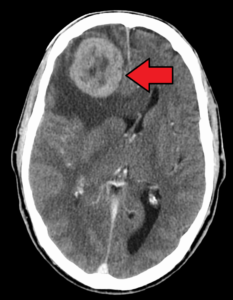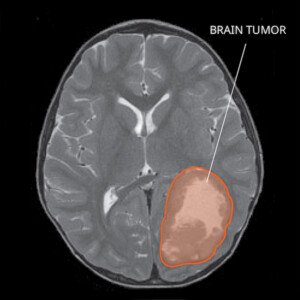
Is there a difference between brain tumor headaches and normal headaches?
Answers to brain tumor headache questions you could never find are now right here.
I asked an expert questions about brain tumor headaches that you’ve wondered about.
Headaches are so common.
Is there a way to tell the difference between brain tumor headaches and regular headaches?
I asked Virginia Stark-Vance, MD, who specializes in the field of neuro-oncology (treatment of brain and spinal cord malignancies), about BT headaches vs. regular headaches.
She is coauthor of the book, “100 Questions and Answers about Brain Tumors.”
Do BT headaches necessarily feel like a “brain tumor headache”? Or can it feel normal?
Dr. Stark-Vance: “A tension headache, often felt as tightening in the back of the head or neck, is a common symptom in brain tumor patients who have a tumor in the back of the head, or causing pressure on the lateral ventricles, the spinal fluid spaces in the middle of the brain.
“The pressure from the tumor seems to transmit to the back of the head and downwards.
“It is not unusual for such patients to see a chiropractor, thinking they have a neck problem.”

Credit: James Heilman, MD
What are unique characteristics of BT headaches that differ from regular (tension, dehydration) headaches?
“There are no truly unique characteristics, although some patients will have an increase in pain with changes in barometric pressure, during a flight, or with changes in altitude.
“Some have a headache when bending forward or coughing. However, absence of these signs isn’t unusual either. Some brain tumor patients never have a headache.”
How do BT headaches differ from migraines and cluster headaches?
“Patients who have a history of migraines who develop a tumor often say their ‘tumor headache’ is different from their ‘migraine’ headache. They are not relieved with the same medication.
“Often the migraine headache is accompanied by nausea and sensitivity to light. Most brain tumor headaches are not accompanied by nausea.”
Are BT headaches necessarily confined to one area (pinpointed), or can they be in the entire head?
“Some patients describe their headache as poorly localized, at the top of the head, or the whole head. Some never describe it as a headache, just as ‘pressure.’
“They usually do not throb, but can radiate to the top of the head, behind the eye, or the back of the head.”
Is it typical or possible for the first incidence of BT headaches to be unbearable pain?
Or is the first headache almost always a mild pain?
“Sometimes patients have ‘the worst headache of their life’ when they present with a brain tumor, almost like an intracranial hemorrhage.
“More commonly, a patient will describe a more subtle headache; it can come and go, sometimes worse in the morning.
“Many patients have not even taken Tylenol for a headache.”
What percentage of patients experience only headaches as a symptom?
“Some patients have headache as the only symptom, or as the first symptom. Obviously not every patient with a headache gets a CT or MRI.
“Often a physician will look for some other problem (weakness, visual problems, dizziness) before ordering a scan on a patient with a headache.
“Some physicians have been successfully sued because they didn’t order a scan after the patient complained repeatedly of headache, but the physician didn’t order the scan because no other signs or symptoms were present.”
What about the tumor causes headaches?
“A ‘brain tumor headache’ in the classical sense, is a headache caused by the pressure of a tumor against the meninges, skull, or another structure that has pain receptors.
“The brain has no pain receptors, per se, but that doesn’t mean all patients are free of headache.”
How big does a BT need to be before it starts causing headaches?

“Some large brain tumors never cause headache; some small brain tumors can cause very severe headaches.
“The latter occurs with tumors in the ventricles that block the flow of spinal fluid.”
Can a person have a BT and NEVER have headaches?
“About 50% of brain tumor patients have headache at the time of diagnosis.
“It has been estimated that 10 million people in the U.S. have a headache on any given day.
“Therefore, the vast majority of people having a headache do not have a brain tumor, since even counting patients with metastatic brain tumors, less than 100,000 people are walking around with a brain tumor of some type.”
Do brain tumor headaches respond to aspirin or ibuprofen?
“Brain tumor headaches may respond to Tylenol, ibuprofen, Darvocet, Vicodin, Fioricet, and many other medications.
“Sometimes the swelling or edema around a brain tumor may be contributing to the headache, and reducing the edema with steroids, mannitol, or other drugs relieves the headache.
“Brain tumor headaches usually do not respond to Imitrex, Amerge, or other migraine drugs.”
What should a person ask himself if he’s afraid he might have a brain tumor?

Shutterstock/B-D-S Piotr Marcinski
The patient should be careful to note any other characteristics of the headache that seem unusual:
- Is the patient prone to headaches, or is this something completely different?
- Is the headache present at certain times every day, such as early in the morning?
- Can the headache be explained by other problems, such as sinus infection or a herniated disk in the neck?
- Are there other symptoms, such as memory loss, dizziness, loss of balance, visual loss, or word-finding difficulty?
- Is there a family history of brain tumors? (only about 5% of BT patients have a family history of brain tumors)
- Is the pain unusual in its location?
- Has the headache persisted over days or weeks? Some brain tumors are so slow-growing that a patient could have a headache for years and still have a brain tumor.
What kind of test should a person insist upon that can rule out a BT?

Freepik.com
“The physician may tell the patient that insurance will not cover a CT or MRI, but if a patient is very concerned, he or she can ask for a referral to a neurologist or headache specialist.
“If the headache becomes very severe, one can always go to an emergency room.
“However, the majority of ER scans are CT scans done without contrast, and some tumors are not detected without contrast.
“A scan done to rule out a brain tumor should be an MRI, which is more sensitive, and should be done with contrast, which will ‘light up’ when there is breakdown of the blood-brain barrier caused by a tumor.”
 Dr. Stark-Vance is a medical oncologist in private practice in Dallas and Fort Worth, providing medical neuro-oncology services to patients of neurosurgical consultants. She received her training in medical oncology at the National Cancer Institute in Bethesda, Maryland. Following her Fellowship, Dr. Stark-Vance served as a clinical investigator at the Cancer Treatment Evaluation Program of NCI. Since her return to Texas in 1996, she has continued developing clinical trials for malignant glioma plus lecture widely on treatment options for primary and metastatic brain tumors. Her work has been published in Journal of Clinical Oncology and Neuro-Oncology.
Dr. Stark-Vance is a medical oncologist in private practice in Dallas and Fort Worth, providing medical neuro-oncology services to patients of neurosurgical consultants. She received her training in medical oncology at the National Cancer Institute in Bethesda, Maryland. Following her Fellowship, Dr. Stark-Vance served as a clinical investigator at the Cancer Treatment Evaluation Program of NCI. Since her return to Texas in 1996, she has continued developing clinical trials for malignant glioma plus lecture widely on treatment options for primary and metastatic brain tumors. Her work has been published in Journal of Clinical Oncology and Neuro-Oncology.
 Lorra Garrick has been covering medical, health and personal security topics for many years, having written thousands of feature articles for a variety of print magazines and websites. She is also a former ACE-certified personal trainer.
Lorra Garrick has been covering medical, health and personal security topics for many years, having written thousands of feature articles for a variety of print magazines and websites. She is also a former ACE-certified personal trainer.
.









































